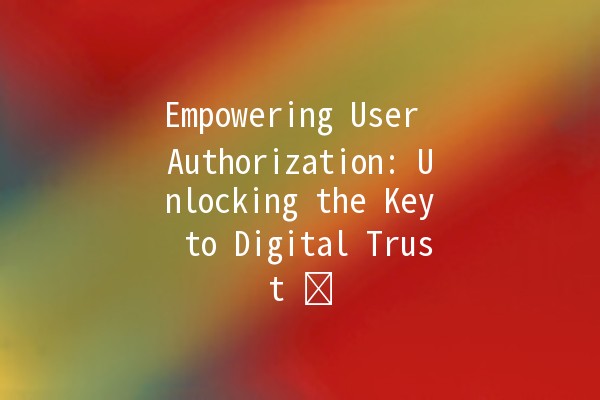




In an age where data breaches and cyber threats are rampant, user authorization has never been more critical. Understanding how to effectively manage user permissions not only enhances security but also builds trust between organizations and their users. This article delves into the foundational elements of user authorization while providing actionable strategies and tips to optimize the user experience.
User authorization refers to the process that determines which resources a user can access and what actions they can perform in a given system. It acts as a gatekeeper, ensuring that only authenticated users can access sensitive information or perform critical operations. In this complex digital landscape, crafting an effective authorization framework is vital for safeguarding user data against unauthorized access.

Data Protection: Proper authorization prevents unauthorized access, safeguarding sensitive data.
User Trust: Building a secure environment fosters trust between users and organizations.
Regulatory Compliance: Many industries have legal obligations regarding data security, making robust authorization essential.
Description: RBAC is a widelyused method that assigns users to predefined roles, each with specific permissions. This strategy simplifies management and ensures that users only have access to what they need.
Practical Example: In an organizational setting, an HR manager may have access to sensitive employee records, while a marketing team member only needs access to campaign data. By implementing RBAC, companies can minimize potential risks from unauthorized access.
Benefits:
Simplifies permission management.
Reduces the chance of misallocation of access rights.
Enhances overall security by limiting exposure.
Description: The principle of least privilege asserts that users should only have the minimum level of access necessary to perform their duties. This approach is paramount in mitigating security risks.
Practical Example: A customer service representative may need to view customer orders but should not have permission to edit user account settings. Ensuring compliance with PoLP helps maintain tighter control over sensitive data.
Benefits:
Limits the potential impact of insider threats.
Reduces the attack surface for external threats.
Helps in maintaining compliance with regulatory standards.
Description: MFA adds an extra layer of security by requiring users to verify their identity through multiple factors, such as a password, a smartphone authentication app, or a biometric scan.
Practical Example: When logging into an online banking system, a user may enter their password and then receive a verification code via text message. This makes unauthorized access significantly more challenging.
Benefits:
Significantly enhances account security.
Reduces the likelihood of compromised accounts.
Builds user confidence in the system’s security.
Description: Regularly auditing access logs allows organizations to identify and review user activities. This insight helps detect suspicious behavior and ensure compliance with established access policies.
Practical Example: A company might establish a routine to review access logs of sensitive databases every month. By identifying unusual access patterns, organizations can mitigate potential threats before they escalate.
Benefits:
Enables proactive security measures.
Helps organizations meet compliance requirements.
Provides insights into user behavior for improving security policies.
Description: Educating users about the importance of authorization and the practices to maintain security is essential. Users often overlook basic security protocols, which can lead to breaches.
Practical Example: Conducting regular training sessions on recognizing phishing attempts, creating strong passwords, and understanding security procedures can empower users to protect their accounts effectively.
Benefits:
Cultivates a securityaware culture within the organization.
Reduces the likelihood of usergenerated vulnerabilities.
Engages users in the overall security strategy.
Implementing robust user authorization measures is crucial in today's digital ecosystem. By utilizing techniques like rolebased access control, the principle of least privilege, multifactor authentication, regular audits, and user education, organizations can significantly enhance security, foster trust, and comply with regulatory requirements. Keeping these strategies in mind will ensure that your organization's user authorization framework is not only effective but also adaptive to evolving threats and challenges.
Authentication verifies the identity of a user, while authorization determines what resources that user can access. Essentially, authentication is about "who you are," whereas authorization is about "what you can do."
RBAC enhances security by minimizing the number of users with unnecessary access to sensitive information. By assigning specific roles, organizations can implement clear security measures tailored to each user’s responsibilities, thus reducing the risk of data breaches.
If a security breach is suspected, immediately revoke access to the compromised accounts, conduct a thorough investigation to understand the scope of the breach, notify affected users, and take measures to prevent similar incidents in the future.
Access rights should be reviewed regularly, ideally at least once a quarter. This ensures that any changes in user roles, terminations, or job modifications are timely reflected in the access control systems.
Without proper user authorization, organizations expose themselves to various risks, including unauthorized access to sensitive information, data breaches, legal penalties for noncompliance, and significant losses in customer trust.
Yes, user education is vital. Even the most sophisticated authorization systems can be undermined by user negligence, such as poor password practices. Educating users on security best practices can significantly reduce the risk of human error leading to breaches.
By integrating these techniques and maintaining a focus on user education, organizations can create a secure environment that fosters trust and ensures protection against evolving cyber threats. In the realm of digital security, user authorization is a foundational element that demands continuous attention and improvement.